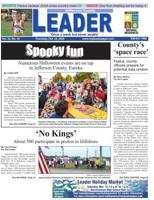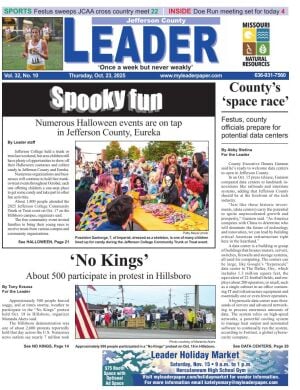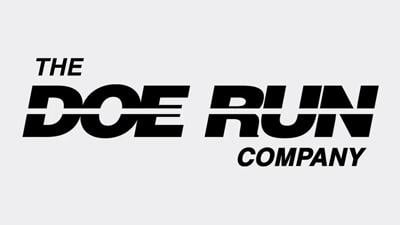The public is invited to an open house-style public meeting about the cleanup of the Doe Run Co. lead smelter in Herculaneum set for 6:30-8:30 p.m. this evening, Oct. 23, at the Herculaneum Amvets Post 42 meeting room, 555 Joachim Ave.
Cleanup of the old Doe Run property site is required before the company can proceed with plans to redevelop the property by expanding port operations in the area.
The Missouri Department of Natural Resources (MoDNR), the U.S. Environmental Protection Agency (EPA) and The Doe Run Co. are co-hosting the meeting, which will include a presentation with questions and answers from 7-8 p.m.
Doe Run is an international lead producer, operating both recycled and primary lead facilities. The company owns approximately 300 acres in Herculaneum along the west bank of the Mississippi River, including more than 6,400 feet of riverfront.
The Herculaneum smelter, at 881 Main St., was an active lead smelter from about 1895 to 2013. Environmental investigations found that emissions from the smelter operations had contaminated the area and properties surrounding the facility with lead. While smelting was ceased in 2013, refinery operations at the site continued until August 2021.
During site investigations between 2013 and 2017, potential sources of contamination were identified, and metals were found in the underlying soil at levels significantly above state and federal standards for residential or non-residential use. Groundwater concentrations of lead at the site also exceeded federal drinking water standards but were found to not be affecting the Mississippi River or local public water supplies.
Doe Run previously conducted cleanup activities, such as yard soil replacement and residential home buyouts. Those activities were focused on off-site property near the facility. The company now plans to focus on cleanup and redevelopment of the 40-acre smelter property, MoDNR reported.
Jennifer Lamons, MoDNR community involvement coordinator, said the Herculaneum smelter property cleanup is required under a consent decree between the EPA and Doe Run but is being overseen by MoDNR.
“Due to the planned redevelopment, day-to-day oversight of the project has been transferred to MoDNR under our Brownfields program, which is especially suited to projects that integrate cleanup and redevelopment.”
Lamons said Doe Run has already cleaned up and demolished the smelter buildings and removed a large volume of smelter slag – a gravel-like material – and taken it to a permitted slag repository.
“The site has a lot of lead-contaminated soil, which only poses a risk to people and the environment if it’s exposed at the surface. Doe Run has proposed regrading the site and capping the contaminated soil with clean fill to eliminate surface exposure,” she said.
Capping the contaminated soil prevents humans and animals from being exposed to waste. Caps also prevent rainwater from soaking into the contaminated soil and leeching waste into the groundwater, MoDNR reported.
Lamons said that cleanups that leave contaminants in place are required to have land-use controls and MoDNR post-closure monitoring.
“The property would be restricted to non-residential uses as well as cap maintenance and non-disturbance requirements by means of an environmental covenant signed by Doe Run as owner, and MoDNR, and filed in the chain of title,” she said. “MoDNR’s Long Term Stewardship Office would monitor post-closure compliance.”
Lamons estimated that the cleanup would take between a few weeks and a few months to complete.
Once the area is cleaned up, she said, Doe Run plans to expand existing port facilities, possibly including the construction of a large warehouse and/or factory facilities.
Lamons said those who attend the open house can expect to see presentations by both MoDNR and Doe Run on the investigation and proposed final cleanup, as well as Doe Run’s redevelopment plans for the site.
Lamons said the public is also invited to submit written comments to MoDNR about the cleanup plan during a public comment period that began Oct. 10 and ends Nov. 10. The plan is available to review at dnr.mo.gov/waste-recycling/sites-regulated-facilities/interest/doe-run-herculaneum-smelter.
Lamons said the public comment period is intended to let the community share concerns about the plan, which could help guide decision-making. Typically these comments could range from concerns about noise, dust and traffic to the safety of water supplies. People also may have questions about how the department will verify that the plan is carried out correctly and how it will ensure the site is clean.
“All feedback is considered, and plans can be changed as a result,” Lamons said. “We also want to hear any community concerns and make sure they are addressed with changes or additions to the plan if need be. As for close neighbors, they do tend to be the most affected by any contaminated site, so we would listen closely to any (of their) concerns.”
To submit written comments, e-mail chris.cady@dnr.mo.gov or mail to Brownfields/Voluntary Cleanup Section, Missouri Department of Natural Resources, P.O. Box 176, Jefferson City, MO 65101.
For questions or more information, call Lamons at 573-522-1540 or email jennifer.lamons@dnr.mo.gov.




